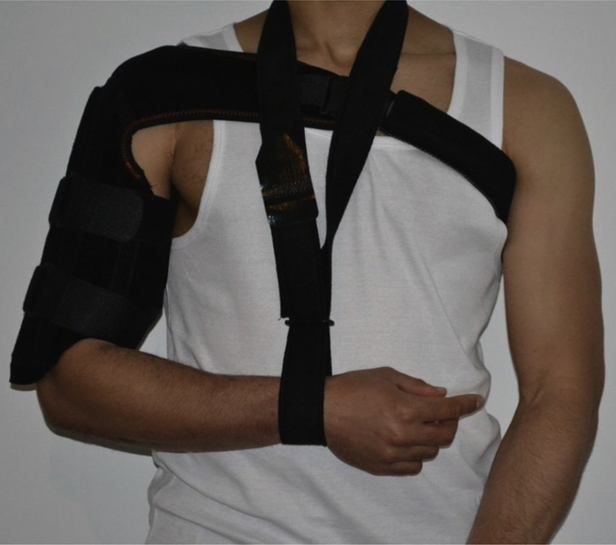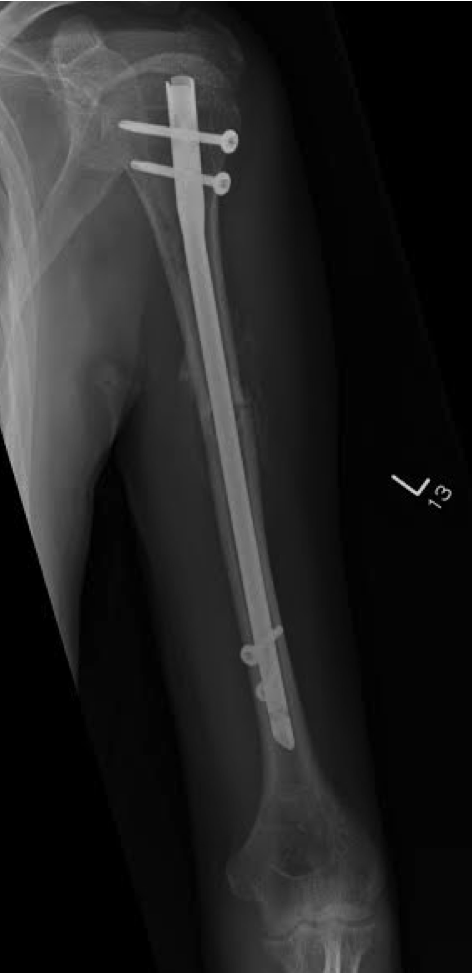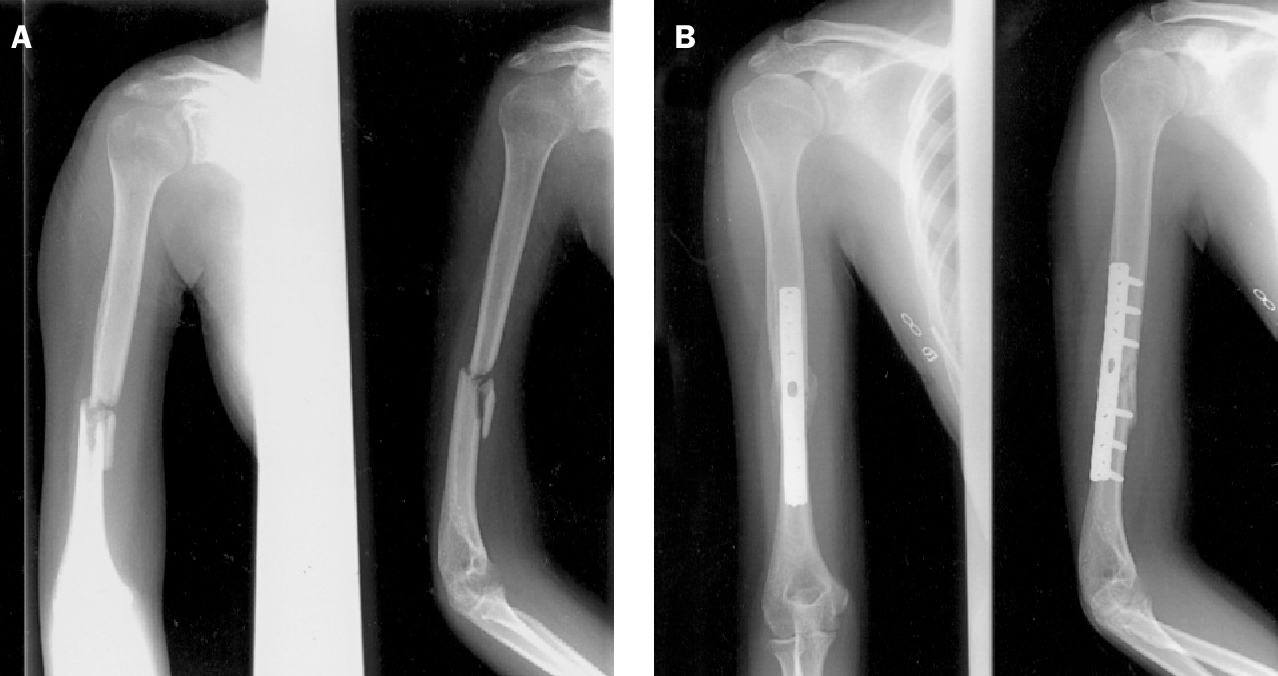Humeral shaft fracturesThe humerus (upper arm) is the bone between the shoulder and the elbow. It can fracture (break) if sufficient trauma is experienced. The fracture can be closed (no wound on the skin) or open, where the skin is damaged and this makes the risk of infection in the bone much higher. In A&E you will be X-rayed and a splint (usually a black Velcro strap) or a plaster will be applied. You will be sent home and given and appointment for the fracture clinic. In the clinic a specialist will explain your injury and the intended plan of action. There are 2 options for management are non operative or operative.
 Non operativeTraditionally it’s felt that the humerus usually heals very well and the bone can tolerate a fair degree of malunion (angulation at the fracture site). This means that even if the bone heals at a non-anatomic angle, this doesn’t tend to alter the appearance of the arm nor reduce the function. The most common way of managing a humeral fracture non-operatively would be to use a brace which is a removeable, Velcro strap with metal struts inside it. Whether or not it can be removed during your treatment depends on the individual case and this should be discussed with your surgeon. The advantages of these over plaster casts are they are lighter, can be removed in some circumstances and also some movement of the elbow, which helps prevent stiffness. The brace would typically be worn for about 2 months. Once pain settles and the X-ray shows signs the bone is starting to heal, the brace can be discontinued. Total treatment time is usually a round 3-4 months. If the bone doesn’t heal, a non-union is declared but I wouldn’t declare that until 5-6 months has been reached.
  Operative treatmentThe two options for surgical management of these injuries are a plate or a nail. Both are applied under general anaesthetic and the operations take about 1-2 hours. A plate is a long piece of metal with holes in for screws and this acts as an internal splint. Once the bone has healed the plate is redundant but it can remain inside the body and wouldn’t usually be a problem. A nail is a long rod which is put in from the shoulder and threaded down towards the elbow and it sits inside the central canal of the bone (the medullary cavity). Screws are placed through the bone and the nail at the top and bottom to stop the nail twisting inside the bone. Again, once the bone heals, the nail is redundant but the nail can remain in place long term. As for whether you’ll be offered a nail or a plate, there are some fractures that lend themselves to one method of treatment more than the other, but also surgeon experience and preference will play a part. Both methods of fixation have a good chance of helping your bone to heal swiftly and comfortably and without complication. However, complications can occur and those are infection, nerve injury, stiffness of the shoulder and/or elbow and of course, non-union of the bone. After the surgery you will still need a sling but not usually a brace or plaster cast. You must keep your wound dry in the bath or shower for 2 weeks to allow it to heal. After about a month a sling may no longer be necessary and you can use your arm for gentle activity. Heavier use of the arm and above-the-shoulder movement usually resumes at about 2-3 months.
Non unionDespite surgeons’ best efforts, sometimes bone just doesn’t seem to want to heal. This can be due to biology (the natural process of bone healing doesn’t seem to have worked) or mechanics (too much or not enough movement at the fracture site). The two main factors most surgeons will take into account when deciding if a non-union has occurred are pain levels of the patient and X-ray findings. Sometimes it is obvious and the arm moves at the fracture site, a so-called pseudo-arthrosis. Once this has been declared there are 2 options. If the non-union is not very troublesome it can be left alone and this would be reasonable in someone who is quite a high risk surgical candidate. Surgical treatment of a non-union involves opening up the fracture site, removing scarred tissue from the fracture and stabilising the bone. Stabilising means holding it still while it heals and that can be with a nail or a plate (as above) although my preference is usually a plate in this non-union situation. Of course, a risk from surgery for non-union is non-union itself. There’s no guarantee it’ll heal just because you’ve had surgery but the chances of it healing are good. Often the surgeon will suggest bone-grafting of the fracture site. I would take your own bone from your iliac crest. This is the lip of bone where your trouser bet sits. You won’t miss the bone from here and it re-grows. It can be quite sore though for a few weeks after the surgery. By taking bone from here, the new cells encourage the non-union to start to heal naturally. 
|